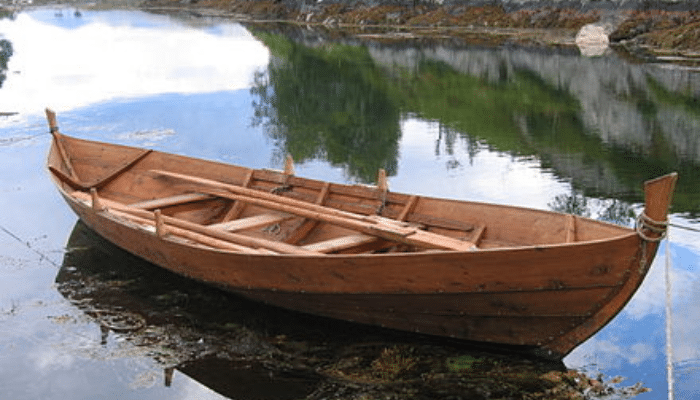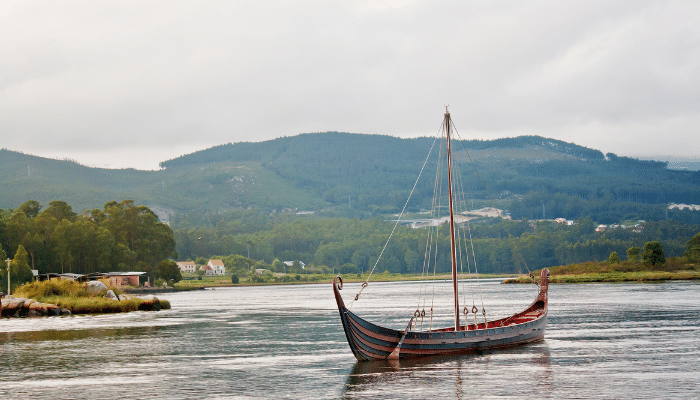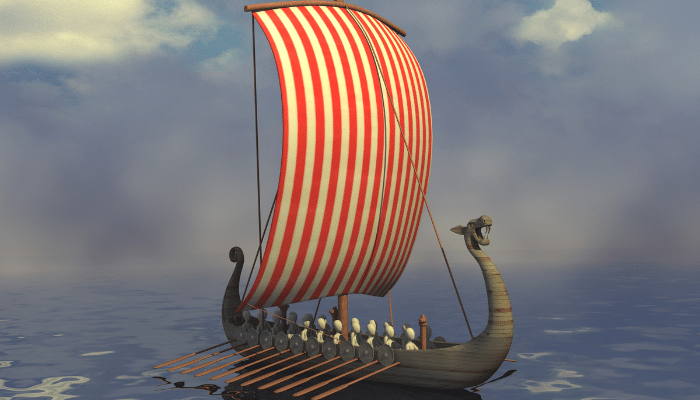Types of Viking Ships
Vikings were seafaring traders and raiders from the Scandinavian region, including Norway, Denmark, Finland and Sweden. In the Viking Age ( AD 700-1100), they sailed around the European coast to engage in trade with those from Arab and eastern regions.
Vikings took walrus ivory, furs and animal skins, whalebone, and amber from Scandinavia and bought wheat, honey, and wool from Britain, salt and wine from France and glass from Italy. They also procured silk, spices and silver from merchants from the east.
They also made longer voyages when they sought lands to settle, going as far as Iceland, Canada, Greenland and North America.
For these purposes, they built different types of ships, ranging from small fishing vessels to longships, all from timber planks, commonly oak, that were overlapped and nailed in place firmly.
To make their ships watertight, they filled the tiny gaps between planks with animal hair, moss or wool mixed with tar or tallow. The vessels were long, narrow, and had shallow draughts.
They employed their famous longships for raiding and carrying their warriors. The front of this ship was decorated with a carving of an animal head like a snake or a dragon. Knarr or cargo ships were used for the transport of goods. They were wider and slower than longships.
Viking ships were propelled by oars or by the force of the wind and had a large, square sail, usually made from wool with criss-crossed leather strips, so it kept its shape when it got wet. Ships were steered using a steering oar or steerboard held in place on the right-hand side of the ship.
Given the weather conditions, the Vikings did not go on voyages in winter but waited until spring season.
They didn’t have maps but observed the position of the suns and stars, the motion of the waves and the direction of the wind to know which way was land. They did not use a compass but might have used a sun-shadow board to aid them in navigation.
Coming to types of Viking Ships, they can be divided into four types: the Faering, the Knar, the Karve and the Longships.
The Faering
A Faering is a small open boat with two pairs of oars with a history going back to the Viking era. It was common in the boat-building communities in the western and northern parts of Scandinavia and is still used today.
They are clinker-built, with their planks overlapping each other and sewn together to create their hulls. Some Faerings also carried a small square sail apart from the oars.
It was employed for coastal sailing and also for fishing, trading and as a personal craft. The earliest ones solely depended on oars, but later, they also had a sail that could be attached if needed.
The primary difference between the two configurations was the position of the rudder. Oars function as rudders to the vessel’s side; the stern needs a stern-mounted rudder to direct the vessel. Today, they are used as fishing vessels and sometimes raced too.

A subclass of the Faering, the Femboring is also an open, clinked type of wooden boat with similar proportions and appearance as the Faerings. It was built with fir or pine and could be rowed or sailed as fishing boats.
Some Faerings have been discovered by archaeologists and can be seen in Europe’s Naval Museums.
The Vikings buried their chiefs with their ships, and many such burials have been found. For instance, the Gokstad Faering was the smaller of the 2 boats in the burial of goods of the person buried on the famous Gokstad ship.
One of the most astounding burials of the Viking era, the Gokstad ship burial dates back to the 9th century and has a ship and 2 boats buried with it. What makes it so special is that the ships were found quite well preserved and have been restored. One can see them at the Viking Ship Museum in Oslo.
The Knarr
Knarr ships were mainly constructed for transporting cargo, including walrus ivory, wheat, timber, wool, honey, and slaves. It also supplied food, drinks, armour, and weapons to traders along their voyages across the Baltic Sea and the Mediterranean Sea.
They were the merchant ships of the Vikings and were 16 m or 54 ft long and had a 15 ft or 4.6 m beam. Their hull could carry around 24 tonnes, and they had a displacement of 50 tonnes.
Knarrs were strong and were propelled by sails. Oars were used only when there was no wind on the open waters. They were employed on longer voyages that were perilous. They could sail 121 km or 75 miles in a day with a 20 to 30-member crew.
They often traversed the North Atlantic, loaded with livestock, furs, skins, etc and other goods to and from Greenland and the North Atlantic Islands.
Knarrs were broader than the warships of Vikings. They also had wider and deeper hulls for accommodating cargo and depended on sails rather than oars.

They were slow, as speed was not a priority. Knarrs were seaworthy ships that crossed vast stretches of open oceans. They mostly operated along the Scandinavian Coast and in open seas towards the west, carrying items for trade.
A well-preserved Knarr was discovered in 1962 by archaeologists in a channel in Denmark’s Roskilde Fjord.
It was known as Skuldelev 1 and was placed between 2 warships. Experts say its placement suggests that it was meant to restrict the channel against rival raiders and their ships.
Now, all 5 ships, called Skuldelev ships, are kept in Roskilde’s Viking Ship Museum.
It is also said that the design of the Knarr influenced the design of the cog, a ship used during the Middle Ages for trade, transport and also in war from the 10th century onwards.
It was made of oak and had a single mast and a single square sail. Cog was mainly used for trade in northwest medieval Europe, mostly in the Baltic Sea by the Hanseatic League.
Longships
Longships are said to be the finest vessels built by the Vikings, known for their exceptional seafaring and boat-building skills, which were way ahead of their time.
Longships were used for exploration, warfare and even trade. They were made of timber and had an elongated design which could handle even the roughest waters and the harshest conditions at sea. Their speed varied between 5 to 10 knots an hour, while the maximum speed they could attain was 15 knots an hour. Franks referred to longships as Dragonships due to their dragon-shaped bow.
These long, narrow and lightweight wooden boats, with a shallow draft, could operate in waters just a metre deep.
They were double-ended and could reverse their direction without turning around. They had oars, but the later versions also carried a rectangular sail on a mast, which was only used in long voyages.

Longships portrayed Viking power and were highly valued. They were owned by the wealthy.
Though longships were employed by the Vikings in warfare, there are no detailed descriptions of naval tactics. However, we do know that sometimes, these ships were tied together to create a platform for infantry warfare.
Longships are of different kinds and differ on the basis of size, shape, etc. The easiest way to classify them is by counting the number of rowing positions on board.
Let’s look at the 4 types of longships- the Karvi, Snekkja, Skeid and Drakker.
Karvi/Karve
The karvi/karve was a relatively small vessel in the Viking longship fleet and was used for fishing, trade and transport of goods. It was also seldom used for warfare.
It had 13 rowing benches, but all vessels having 6-16 benches were classified as karvi. Its design and structure made it ideal for operating in shallow waters and for coasting.
Karvi had a wide hull like the Knar and were often employed for carrying people, goods and even animals.
The most popular karvi discovered to date is the Gokstad Ship. It was found in an excavation in 1880 and dates back to the 9th century. It was 23 m long and was considered to be larger than the usual karvi ships.
Snekkja
Snekkja or Snekke, which translates to snakes in English, is the most common Viking longship, named so due to her sleek, slender and streamlined body that made a perfect vessel for combat at sea.
It had at least 20 rowing benches and could carry 40 oarsmen. Snekkja was built in different sizes. However, a typical Snekkja was about 17 m long.
These vessels were meant for deep waters and could be used in fjords since they were lightweight and had a gentle curvature in their hull, which enabled them to land on pebbled and sandy beaches. They were strong and capable of handling harsh weather at sea, which made them popular during the Viking era.
Skeid
Skeid, or slider, is one of the biggest Viking ships used in warfare. It has 30 or more rowing benches. One of the largest Skeids was found in the 1990s in Roskilde Harbour, Denmark.
The vessel was 37 m long and was named Roskilde 6. It is said to have been constructed at the end of the Viking era, around 1025. It was one of the 9 Viking-era ships found in the region.
Drakker
Drakker or Drakar, meaning dragon, was a longship which was decorated with many carvings of animals, including snakes and dragons, probably a sign of Viking power and to ward off evil spirits and sea monsters.
Another reason is that carving heads of creatures like dragons or snakes on either end of the ship was meant to intimidate enemies and those during raids and pillages. As these ships came to the shore, their distinguishing carvings made them stand apart from other vessels and instilled fear in the hearts of the enemies.
Draker had 30 rowing benches and more, but it is the Viking vessel about which only little information is available to us.
Byrding
Byrding was a light freight vessel and more manoeuvrable than the Knarr. It could be easily pulled to the shore and transported goods and merchants over respectable distances. They relied more on oars.
They were smaller than the Knarr and even smaller, shorter and narrower than the Karv. Byrding could have been 12-17 m in size, per experts.
Byrding was capable of deep-sea navigation over respectable distances, such as between Iceland and Norway. During raids and attacks on enemies, they were used to carry food, water and other supplies. With Christianisation and the coming of southern roundships, the Byrding became less popular.
Conclusion
Vikings were skilled seafarers, and their ship-building techniques were ahead of their time. They were quite knowledgeable when it came to judging wind speeds, calculating distance and locating land.
Archaeologists have found many Viking Ships buried in several places in Scandinavia that have yielded vital information about the Vikings and their way of life. Sundials have also been found on these ships, pointing to the fact that they were occasionally used in the early Viking era.
You might also like to read-
- What are Viking Ships?
- How Vikings Used “Sunstones” for Navigation at Sea?
- 8 Interesting Facts About Cape Cornwall
- 8 Interesting Facts About Cape Route
- Top 10 Fjords in Norway
Disclaimer: The authors’ views expressed in this article do not necessarily reflect the views of Marine Insight. Data and charts, if used in the article, have been sourced from available information and have not been authenticated by any statutory authority. The author and Marine Insight do not claim it to be accurate nor accept any responsibility for the same. The views constitute only the opinions and do not constitute any guidelines or recommendations on any course of action to be followed by the reader.
The article or images cannot be reproduced, copied, shared or used in any form without the permission of the author and Marine Insight.
Do you have info to share with us ? Suggest a correction

About Author
Zahra is an alumna of Miranda House, University of Delhi. She is an avid writer, possessing immaculate research and editing skills. Author of several academic papers, she has also worked as a freelance writer, producing many technical, creative and marketing pieces. A true aesthete at heart, she loves books a little more than anything else.
Subscribe To Our Newsletters
By subscribing, you agree to our Privacy Policy and may receive occasional deal communications; you can unsubscribe anytime.



